"Extra" Pages: Los Angeles 1906 Labor Day
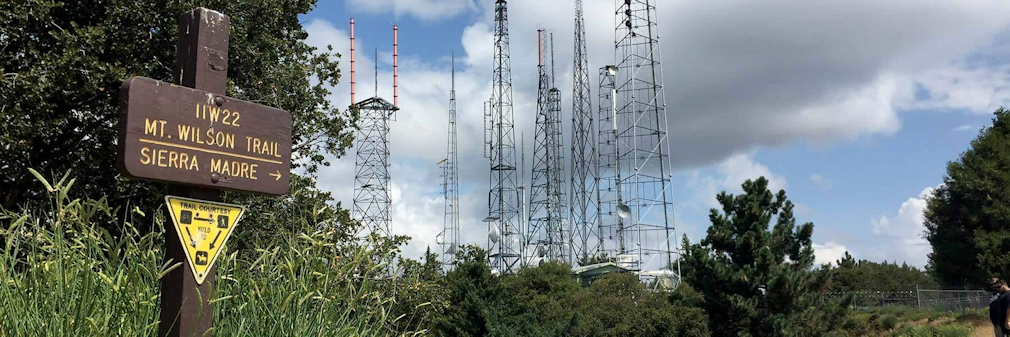
Mt. Wilson Trail today is the mountain where most of the television and radio stations house their transmitters because of its location over the Los Angeles basin.
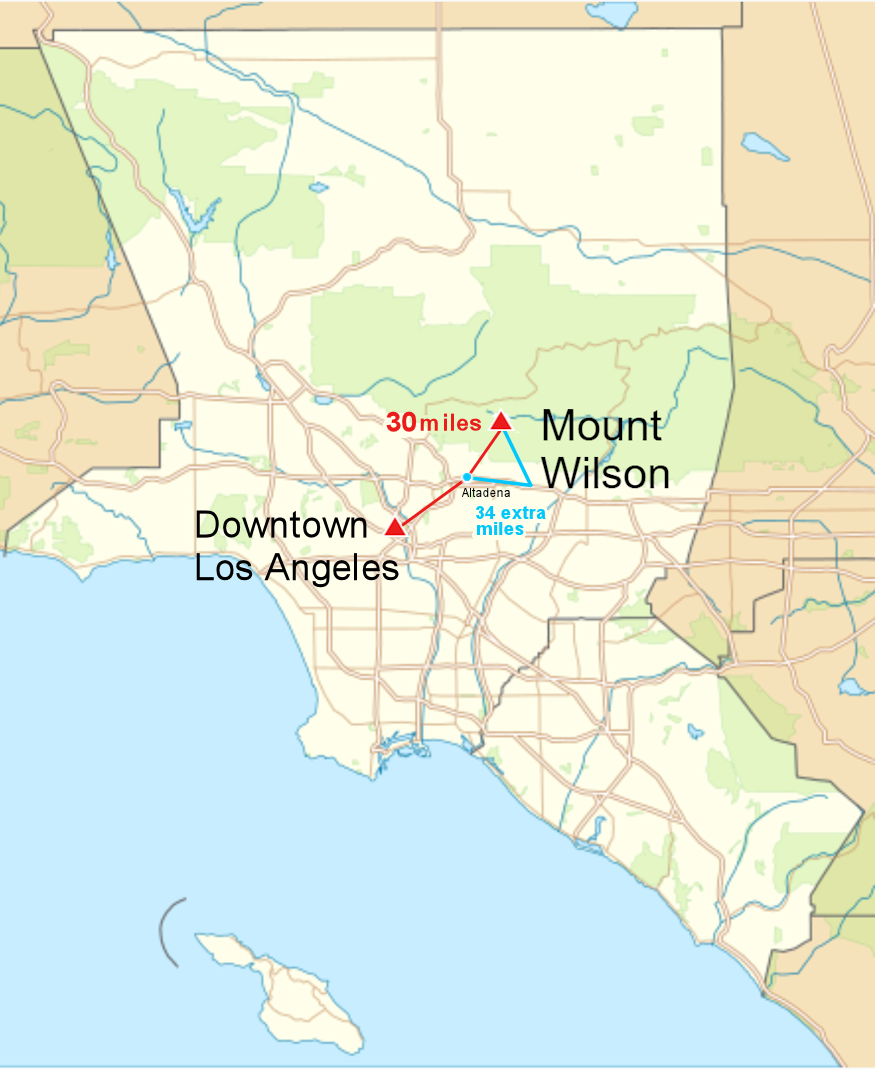
 This graphic of a map of Los Angeles
This graphic of a map of Los Angeles
County illustrates the problem. Before we
were aware of the Mt. Lowe Railway the only
option we could find we the boys hiking down
Mt. Wilson to Azusa and then taking an
incredibly slow mule trolley 23 miles to
Altadena to catch the electric train to down-
town. An extra 34 miles taking several hours
INTRODUCTION: It suddenly all comes together.
The telling of the story of Woodward's tragic gun accident of 1906 is an epic 6,000+ word, 531 HTML-coded lines with 74,000 characters and 50 image page. By far the biggest endeavor the website has ever undertaken. It would be four years in the making. The greatest obstacle we faced was discovering a suitable explanation, one that fit the timeline given by the newspapers, as to how the three young men returned to downtown Los Angeles from a weekend of camping on Mount Wilson 23 miles to the northeast. A 23 mile hike back to Los Angeles, traveling down narrow mules trails, in the dark, from an elevation of 5,680ft to the 255ft above sea level that is downtown Los Angeles would take most all of the night.
Initially, we considered that they could have caught a mule trolley somewhere near Azusa, CA but even then it would be impossible to make it to the apartment hotel where the boys were staying on time for 8:00 a.m. (as you will learn from our Happy Trails page on the mule rides). As it is with many discoveries in our efforts to sort out the events of Woodward's life, we stumbled on the information regarding the Mount Lowe Alpine Railway while researching the trails of the San Gabriel Mountains. It was not any one of the hundred or so Google searches we performed prior regarding transportation at the time of the accident! It was reading a hikers blog about those trails that alerted us to the remains of the railway. A quick search afterwards produced volumes of information on the Mount Lowe Railway. What was still missing was (1) how the boys got from Mt. Wilson to Mt. Lowe given there was a canyon between the two and (2) what electric train the boys took to get back by 8:00 a.m. Now that we knew what we were looking for, again the hiker's blog filled in the gap - Eaton Saddle - as being the only viable passage to transverse the canyon. Google maps, using the hiking feature, not only showed the trail, it then told us the journey is 3.7 miles and would take roughly one hour and twenty minutes. It was starting to fall into place.
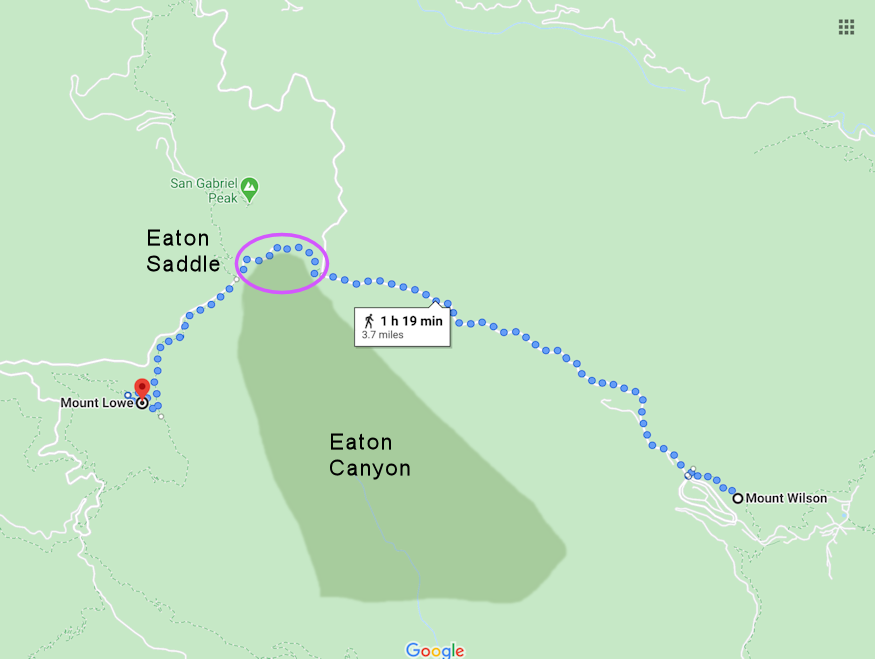
 A capture from Google maps hiking feature now
A capture from Google maps hiking feature now
showing us the trail that alluded us on previous maps.
The next issue was how did the boys take the electric rail from the Alpine Tavern near Mt. Lowe's peak to downtown Los Angeles by 8:00 a.m. given that by all accounts the first trip to Mt. Lowe did not leave downtown LA until 8? This was the next challenge. It was then, after hours of reading the various webpages devoted to the railway that we learned the railway was, for a number of years of its operation, the most popular tourist sight in California, more so than even Yosemite National Park. We came across plenty of advertisements claiming the ride was 2 hours long [actually the climb took about 20 to 30 minutes longer than the decent]. Reading these various webpages we begin to piece together our answer. We discover the Pasadena Pacific Electric Railway offered "sunrise special" rides leaving downtown Los Angeles at 2:30 in the morning. Another piece now appears to fit the puzzle. If the sunrise special were to return to LA leaving the Alpine Tavern around 5:30 and no later than 5:45 would put the boys one block from the Castle Craig Hotel by, at the latest, 7:45 a.m. fitting the timeline necessary to the story.
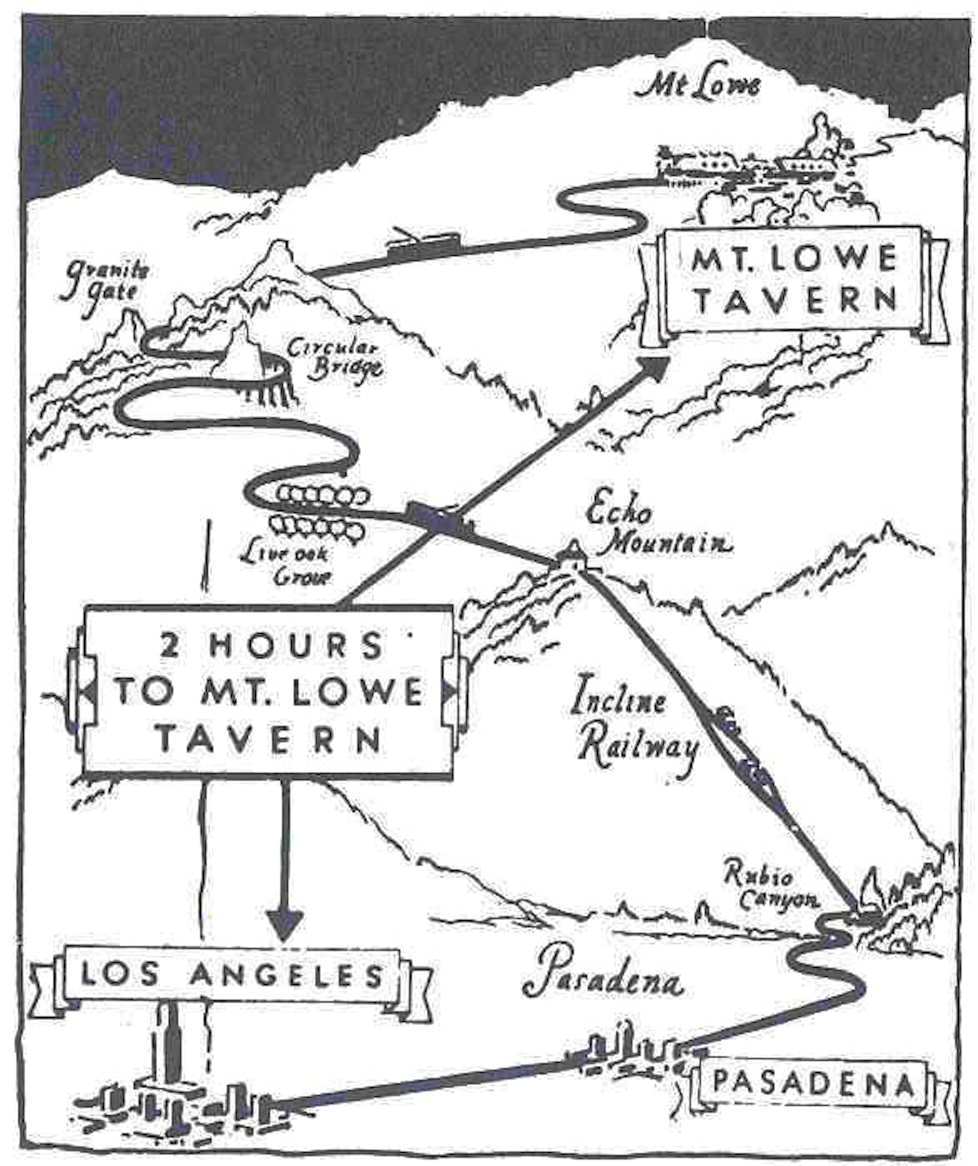
 A clipping from a newspaper illustrating
A clipping from a newspaper illustrating
the time from the Alpine Tavern to downtown.
The "sunrise special" is only mentioned specifically in one source. It is in reference to the only year the Mt. Lowe railway was profitable (1926) of its 40 year existence. Reportedly, the "sunrise special" was the railway's most popular ride. The article does not say if it ran daily or how long the ride had been offered or any other detail. The preponderance of the evidence, however, begins to offer us some insight. We learn that there were numerous special railway schedules for holidays, without mentioning the "sunrise specialā" specifically because Pasadena Pacific Electric Railway marketed itself as a "mountains to the sea" provider. Other popular routes took Los Angelenos to the Balboa Park Pavilion in the Newport, Long Beach area, the Cawston Ostrich Farm in South Pasadena and then there is the Balloon Route that boasted "10 beaches and 8 cities" and "101 miles for 100 cents in 1 day." All of which ran on special holiday schedules.
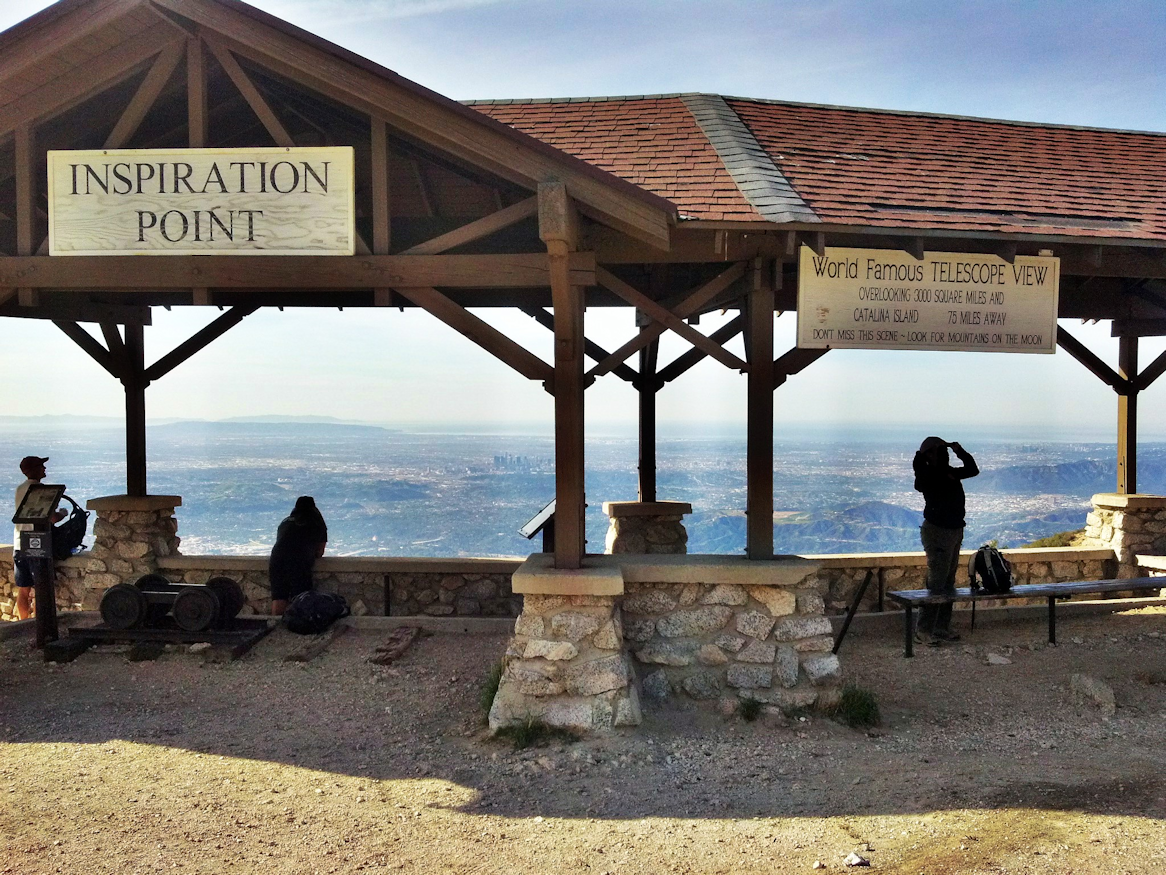
 Inspiration Point Echo Canyon today. Sunday
Inspiration Point Echo Canyon today. Sunday
sunrise services were held here for years. The
most popular being Easter Services.
Another seemingly unrelated fact was we learned that a popular church service was held at Inspiration Point overlooking Castle Canyon on Echo Mountain every Sunday. There were two services, one shortly after sunrise and the next shortly after the 10 a.m. trolley arrives. There is no specific mention of a sunrise trolley in these accounts, however, we find it hard to believe there would not also be a train bringing congregants to the first service. By the services' schedule, it appears the services were timed to coincide with the arrivals of the trolleys. If it were not for our discovery of the "sunrise special" our whole premise falls apart. There is no other way, besides Woodward and his friends traveling most all of the night on mule and by horse trolley, that gets the group from Mt. Wilson to downtown LA by 8. We find that scenario very unlikely given (1) they were expected back the night before and if you were going to travel all night why not leave on the last ride just hours prior when you would have to start your trek home? And (2) in all likelihood they had plans for the next day. So it seems unlikely they would risk no sleep ruining their plans. Despite our lack of confirmation there was a "sunrise special" trolley that morning, the preponderance of other evidence and the fact that there is only one other way the three young men could have arrived at the Castle Craig Hotel Apartments by 8 a.m. Monday morning we are satisfied the best bet is they took the departing sunrise special trolley back to Los Angeles.
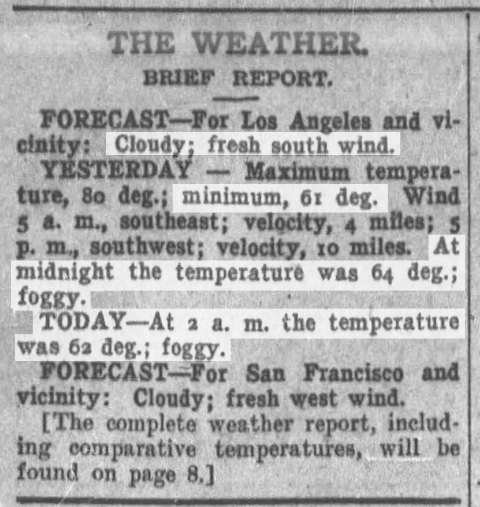
 Los Angeles Times Sept 3, 1906
Los Angeles Times Sept 3, 1906
Brief Weather report. Note that we checked
out page 8 and it was the same.
With that all falling into place, what we needed to learn now was a plausible reason why Woodward would be wearing a sweater over his holstered revolver? We needed to learn more about the weather on that particular day. Numerous searches online produced no results. We could only get a general idea of the temperatures that day from averages. We need to search the actual newspapers, which meant a subscription to newspapers.com. There we learn that the temperatures in the LA basin at 5:00 a.m. the morning of the accident would be cloudy, with fog in the morning and roughly 61 F degrees. There is a formula to factor the change in temperature per thousand feet of elevation. It is 3.5 degrees per 1,000ft. If Los Angeles was 61 degrees at 5:00 a.m., then the temperature at 4,400ft el. at 5:00 a.m. was roughly 47 F degrees. Add that it is overcast skies and a fog expected over the Los Angeles Basin, it was certainly cold enough to throw a sweater on after hiking nearly 4 miles over hilly terrain. Throw in the fact that the trolley cars are not enclosed, but rather open car, then it is not a reach to postulate when he would most likely added the sweater. It is possible he put it on while riding the trolley but nonetheless, either is suitable.
The subscription to newspapers.com opened up other avenues of investigation. What was going on in LA that day? Would there be a parade? Where would it be held? And at what time? How big would it be? Was there anything else that would draw our attention? Our search for these answers gives us more than we can imagine. First, we learn that there was a Japan Day held in Venice Beach. It would be the first of its kind outside of Japan itself honoring the Emperor's birthday. Next to that article we find another article regarding Woodward's accident previously unknown to us! Following that trail, we find still another article published the day of the accident. We also learn that over 10,000 union workers take part in the parade. Labor Unions were, as we suppose they always will be, quite a contentious issue. A number of local papers could not or refused to hide their contempt from the angle upon how they presented the parade.
September 3, 1906, the day of RSW's accident, it turns out, was a very historic day for the city of Los Angeles for a number of reason aside from Woodward's accident. There are also accounts of peoples comings and goings the day of, as well as, information about congestion on the city rails and how busy were the beaches and mountains. The information that follows is a bit eclectic and all over the map. It is items the were not pertinant enough to make the main accident page but are still interesting in their own right to Woodward, even if the relationship is at best peripheral. We also provide information about such things as, Chief Auble's fasinating and ironic story, and some tidbits about the financial district of downtown LA, including Orion's office location and some business dealings. But first, a quick discussion about Eaton Saddle and the questions that remain unanswered...
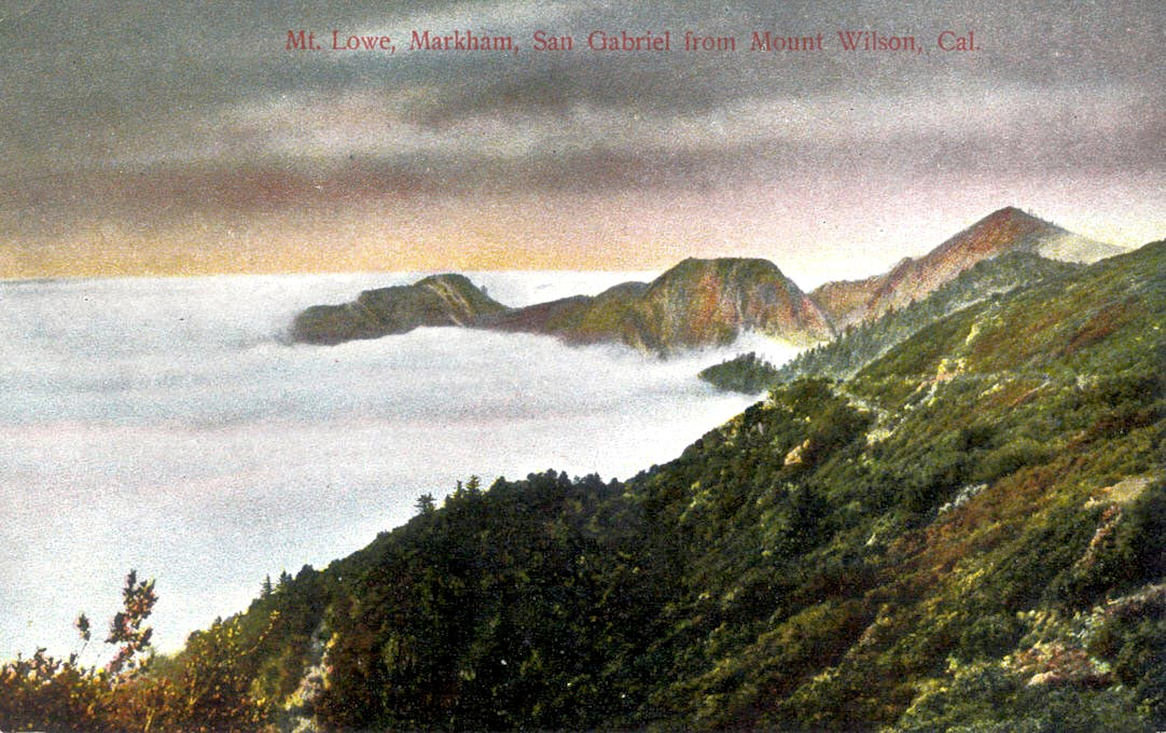
 Postcard of Mounts Lowe and Markham from Mt. Wilson.
Postcard of Mounts Lowe and Markham from Mt. Wilson.
As stated elsewhere, we could NOT find a picture or postcard
of the San Gabriel Mountains without low hanging clouds.
"EXTRAS" PAGES RELATED TO RSW'S 1906 ACCIDENT |
||||
Our Journey  CURRENT PAGE |
Happy Trails  AVAILABLE |
Chief Walter Auble  AVAILABLE |
Parades & Festivals  COMING SOON |
Accident Page  RETURN TO PAGE |
Selected Old Footage of the Mount Lowe Railway✽ ALL LINKS will open to a new tab in YouTube ✽ |
||
| TITLE & LINK | LENGTH | DESCRIPTION |
A Trip Up Mount Lowe With The Ford Camera Man" Mt. Lowe Railway & Funicular Pasadena 17324b |
8m : 21s |
Terrific original footage produced by Henry Ford of the climb up the electric alpine railway. It is an old-styled silent film! The film has its moments but because it is the original footage, is some what damaged. |
Mt. Lowe Railway - What Remains |
3m : 55s |
Produced by AOL (2012) in conjunction with the Mt. Lowe Preservation Society and the Pasadena Museum of History this short package provides good historical perspective and images. |
32m : 29s |
This lengthy video appears to have been an early made-for-television production on the railway found on VHS in the Pasadena Library archives. It uses a lot of the Ford footage with narration and organ music. |
|
4m : 07s |
A nice video of rare pictures accompanied by a nice folk-like song about the Mt. Lowe Railway by the Vin Fiz Flyer Bluegrass Band. The pictures are great and some are one's we've never seen before! |
|
Mount Lowe Railroad to Echo House |
5m : 14s |
This video feels like it was possibly made as a news package for the movies, like the Movietone News Reels. It uses Ford's original footage with voice over narration. |
1m : 11s |
Another short video that feels like a news package using the Ford footage and a narrator. |
|
There are also a number of terrific modern videos of the trails today... Use this link to see all the choices on YouTube. |
||
